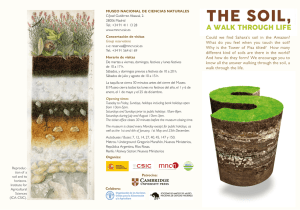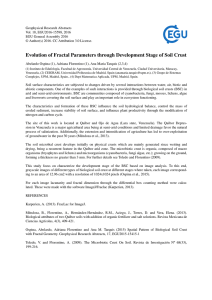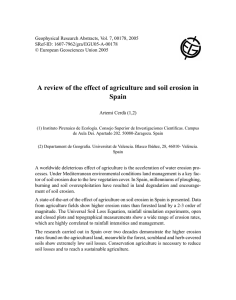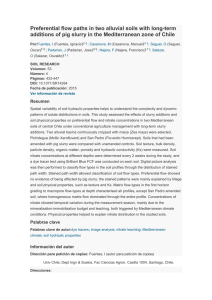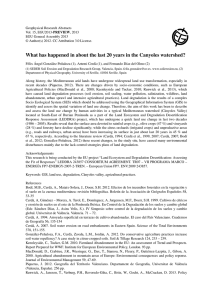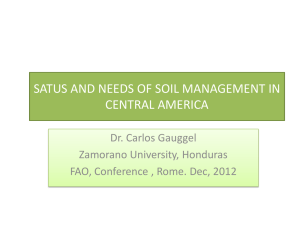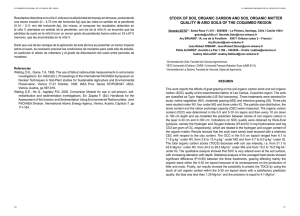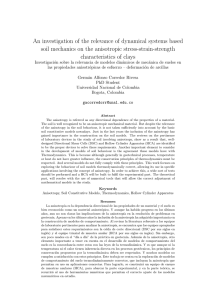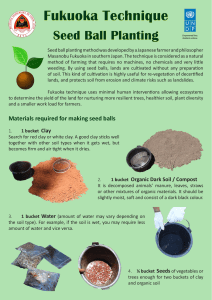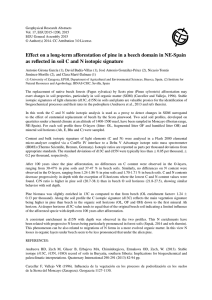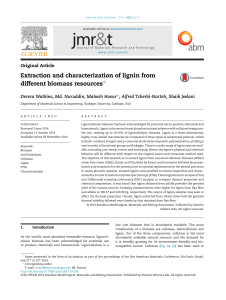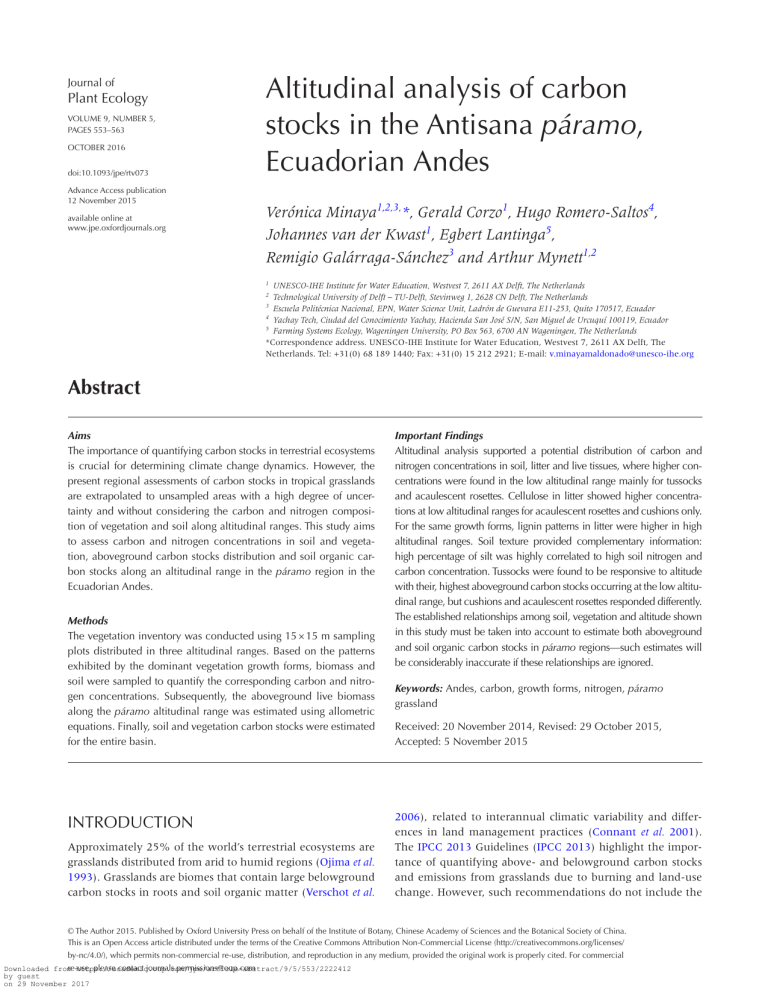
Journal of Plant Ecology VOLUME 9, NUMBER 5, PAGES 553–563 October 2016 doi:10.1093/jpe/rtv073 Advance Access publication 12 November 2015 available online at www.jpe.oxfordjournals.org Altitudinal analysis of carbon stocks in the Antisana páramo, Ecuadorian Andes Verónica Minaya1,2,3,*, Gerald Corzo1, Hugo Romero-Saltos4, Johannes van der Kwast1, Egbert Lantinga5, Remigio Galárraga-Sánchez3 and Arthur Mynett1,2 1 UNESCO-IHE Institute for Water Education, Westvest 7, 2611 AX Delft, The Netherlands Technological University of Delft – TU-Delft, Stevinweg 1, 2628 CN Delft, The Netherlands 3 Escuela Politécnica Nacional, EPN, Water Science Unit, Ladrón de Guevara E11-253, Quito 170517, Ecuador 4 Yachay Tech, Ciudad del Conocimiento Yachay, Hacienda San José S/N, San Miguel de Urcuquí 100119, Ecuador 5 Farming Systems Ecology, Wageningen University, PO Box 563, 6700 AN Wageningen, The Netherlands *Correspondence address. UNESCO-IHE Institute for Water Education, Westvest 7, 2611 AX Delft, The Netherlands. Tel: +31(0) 68 189 1440; Fax: +31(0) 15 212 2921; E-mail: v.minayamaldonado@unesco-ihe.org 2 Abstract Aims The importance of quantifying carbon stocks in terrestrial ecosystems is crucial for determining climate change dynamics. However, the present regional assessments of carbon stocks in tropical grasslands are extrapolated to unsampled areas with a high degree of uncertainty and without considering the carbon and nitrogen composition of vegetation and soil along altitudinal ranges. This study aims to assess carbon and nitrogen concentrations in soil and vegetation, aboveground carbon stocks distribution and soil organic carbon stocks along an altitudinal range in the páramo region in the Ecuadorian Andes. Methods The vegetation inventory was conducted using 15 × 15 m sampling plots distributed in three altitudinal ranges. Based on the patterns exhibited by the dominant vegetation growth forms, biomass and soil were sampled to quantify the corresponding carbon and nitrogen concentrations. Subsequently, the aboveground live biomass along the páramo altitudinal range was estimated using allometric equations. Finally, soil and vegetation carbon stocks were estimated for the entire basin. INTRODUCTION Approximately 25% of the world’s terrestrial ecosystems are grasslands distributed from arid to humid regions (Ojima et al. 1993). Grasslands are biomes that contain large belowground carbon stocks in roots and soil organic matter (Verschot et al. Important Findings Altitudinal analysis supported a potential distribution of carbon and nitrogen concentrations in soil, litter and live tissues, where higher concentrations were found in the low altitudinal range mainly for tussocks and acaulescent rosettes. Cellulose in litter showed higher concentrations at low altitudinal ranges for acaulescent rosettes and cushions only. For the same growth forms, lignin patterns in litter were higher in high altitudinal ranges. Soil texture provided complementary information: high percentage of silt was highly correlated to high soil nitrogen and carbon concentration. Tussocks were found to be responsive to altitude with their, highest aboveground carbon stocks occurring at the low altitudinal range, but cushions and acaulescent rosettes responded differently. The established relationships among soil, vegetation and altitude shown in this study must be taken into account to estimate both aboveground and soil organic carbon stocks in páramo regions—such estimates will be considerably inaccurate if these relationships are ignored. Keywords: Andes, carbon, growth forms, nitrogen, páramo grassland Received: 20 November 2014, Revised: 29 October 2015, Accepted: 5 November 2015 2006), related to interannual climatic variability and differences in land management practices (Connant et al. 2001). The IPCC 2013 Guidelines (IPCC 2013) highlight the importance of quantifying above- and belowground carbon stocks and emissions from grasslands due to burning and land-use change. However, such recommendations do not include the © The Author 2015. Published by Oxford University Press on behalf of the Institute of Botany, Chinese Academy of Sciences and the Botanical Society of China. This is an Open Access article distributed under the terms of the Creative Commons Attribution Non-Commercial License (http://creativecommons.org/licenses/ by-nc/4.0/), which permits non-commercial re-use, distribution, and reproduction in any medium, provided the original work is properly cited. For commercial re-use, please contact journals.permissions@oup.com Downloaded from https://academic.oup.com/jpe/article-abstract/9/5/553/2222412 by guest on 29 November 2017 554 influence of local factors such as altitude, vegetation and soil texture on carbon stocks, which are necessary in order to understand the complex biogeochemical interactions between soil and plant community (Osanai et al. 2012). For example, small clay particles favor water-holding capacity and nutrient contents of the soil (Jobbagy and Jackson 2000) and enhance carbon sequestration by stabilizing soil organic carbon (Paul 1984). The largest montane grasslands in the Neotropics occur in high-altitude ecosystems known as páramos. These are mostly distributed in the northern Andes (Hofstede et al. 2003; Myers et al. 2000) and represent 9.4% of the global grassland area (White et al. 2000). The páramos contain many microhabitats, hold enormous biodiversity and supply important ecosystem services such as water regulation, water provision and carbon storage (Buytaert et al. 2006; Myers et al. 2000). Despite their importance, they are subjected to a high rate of degradation due to grazing, burning and land conversion (Hofstede et al. 1995; Verweij and Budde 1992). Many studies have emphasized the environmental controls on the dynamic pool of carbon in high-latitude (tundra) and high-altitude (páramo) grasslands as a crucial component of the global terrestrial carbon budget, but the effects of vegetation and soil on carbon dynamics in these ecosystems remain unresolved (Alvarez and Lavado 1998; Anthelme and Dangles 2012; Körner 2007; Parton et al. 1987; Paruelo et al. 1997; Paul 1984; Tonneijck et al. 2010). In particular, soil carbon storage in páramos can be large because they occur on volcanic soils (Andosols) (Tonneijck et al. 2010); indeed, it is probably much greater than that contained in vegetation (Kadovic et al. 2012). A common practice to estimate carbon stocks in páramos usually includes only the most common or dominant vegetation: the tussocks from the family Poaceae. However, it is unknown if this methodological approach is accurate enough to estimate the carbon stocks in this ecosystem, given the plethora of species and growth forms that páramos contain. Additionally, there is not much information on how the soil– vegetation interaction affects the carbon stocks along altitudinal ranges, which in turn should influence carbon estimates at the landscape level. The present study attempts to overcome these limitations by (i) describing the vegetation and soil characteristics of a páramo grassland, (ii) using this information to selectively sample carbon and nitrogen concentrations in the living biomass of the most dominant plant growth forms and (iii) determining carbon and nitrogen concentrations in the topsoil underneath the plants sampled. MATERIALS AND METHODS Study site The study site was Los Crespos-Humboldt (LCH) basin, located on the southwestern slope of the Antisana volcano in the Andes of Ecuador (0°30′S, 78°11′W) (Fig. 1). The basin is part of the Antisana Ecological Reserve (628.1 km2), one of Downloaded from https://academic.oup.com/jpe/article-abstract/9/5/553/2222412 by guest on 29 November 2017 Journal of Plant Ecology the main water sources for La Mica Reservoir, which supplies water to the city of Quito, Ecuador’s capital. The LCH basin (15.2 km2, 4010–5300 m a.s.l.) is covered by glacier (15%), moraine (17%) and páramo grassland (68%). Precipitation varies from 900 to 1200 mm/year and the average temperature from 4.8 to 7°C. Sampling design Sampling was conducted during November and December 2012. The sampling strategy was based on a digital elevation model and a topographic map 1:25 000 (IGM 1990) of the LCH basin. Sampling followed a stratified random design (Daniel 2012) that improved the representativeness of the altitudinal range and reduced sampling errors. A total of 27 permanent sampling plots, each measuring 15 × 15 m were divided into 2 × 2 m subplots (except for the subplots at the corners). The plots were randomly established in the low, mid and high areas of the basin (Fig. 1). These three sampling areas, here called catchments, roughly correspond to three altitudinal ranges: low catchment (n = 10 plots, 4000–4200 m a.s.l.), mid catchment (n = 10, 4200–4400 m a.s.l.) and high catchment (n = 7, 4400–4600 m a.s.l.) (Fig. 1). The plots were established facing north using a compass (SILVA professional S15T DCL) and the corners were marked with PVC tubes. The slope, altitude and geographic coordinates of each plot were measured using a clinometer (CL1002), an altimeter (Multi Function Altimeter with Digital Compass) and a GPS (Magellan eXplorist 100), respectively. The floristic inventory was conducted in those plots that did not fall in an area with evident signs of burning or permanent grazing. The sampling method of Mena (1984) was applied to count all individuals per species, and the Braun-Blanquet (1964) method was used to estimate the area covered by all vascular and nonvascular plant species in each 2 × 2-m subplot. For a given area, this method classifies the area covered by a species in seven percentage categories (%): <1, 1–5, 5–15, 15–25, 25–50, 50–75 and ≥75. Plants were further sorted into growth forms according to the classification for Ecuadorian páramos proposed by Ramsay and Oxley (1997): stem rosette, basal rosette, tussock, acaulescent rosette, cushion, upright shrub, prostrate shrub, erect herb, prostrate herb and creeping herb. The cover was determined as the area occupied by the base of the plant. We measured the two horizontal dimensions and applied the formula of an ellipse to calculate the grassland basal area (GBA) for all vegetation growth forms. Botanical vouchers were collected for vascular plants only, as deemed necessary for taxonomical identification (Cleef 1981; Cuatrecasas 1968; Rangel et al. 1983; Ronquillo 2010); vouchers were identified at the National Herbarium of Ecuador (QCNE) and the Catholic University’s Herbarium (QCA), both in Quito. Finally, for each of the main growth forms in each plot, we sampled leaves, leaf litter and roots following standard protocols (Law et al. 2008). In each plot, one topsoil sample (0–0.3 m depth) was collected in each cardinal point, 3 m Minaya et al. | Altitudinal analysis of carbon stocks555 Figure 1: The ‘Los Crespos-Humboldt’ basin on the slope of the Antisana volcano in Ecuador. Sampling plots (n = 27) are shown as crosses (red = low catchment plots, green = mid catchment plots, blue = high catchment plots). Source: ASTER Satellite Image, 15 m resolution. apart from the edge, using a 70-mm soil corer (EIJKELKAMP, model GM085). Samples were collected into clearly labeled dark polyethylene bags and later refrigerated. Laboratory analyses determined using acid detergent fiber methods (ADF 1990) via ANKOM Technology - 01/02 and - 07/02. Lignin (%) and cellulose (%) were calculated as: Lignin (%) = Carbon and nitrogen analyses Leaves, litter and roots were dried at 60°C for 48 h. Soil was dried at room temperature. All dry plant and soil samples were grinded in a mill (Retsch Mixer Mill MM200) at a vibrational frequency of 300 min−1 for 4 min to obtain a homogeneous sample and then dried again at 60°C overnight. These samples, placed on a tarred tin capsule, were weighed to the nearest hundredth of a gram using a digital lab scale balance (Mettler Toledo AE100). Carbon and nitrogen concentrations in plant and soil samples were measured by an EA1108 CHN-O Element Analyzer (Fisons Instrument) using the Dumas Combustion Method (Dumas 1826; cited by Buckee 1994). Cellulose (%) = W4 - (W1C 2) 100(1) W2 W3 - (W1C1) 100 - Lignin(%) (2) W2 where W1 is the bag tare weight; W2 is the sample dry weight; W3 is the weight after the extraction process; W4 is the weight of organic matter (loss of weight of bag ignited at 525°C for 3 h, plus fiber residue); C1 is the blank bag correction (final oven dried weight/original blank bag weight) and C2 is the ash corrected blank bag (loss of weight on ignition of bag/original blank bag weight). Data treatment and analyses Lignin and cellulose in plants Altitudinal effects on growth forms and plant/soil chemical composition To measure lignin and cellulose in roots and litter, dry samples were grinded, sieved through a 1-mm mesh and then placed in a F57 filter bag. Lignin and cellulose concentrations were Tukey multiple comparisons tests (Tukey 1991) were used to compare carbon and nitrogen pools among different altitudinal ranges. Cellulose and lignin concentrations along the Downloaded from https://academic.oup.com/jpe/article-abstract/9/5/553/2222412 by guest on 29 November 2017 556 Journal of Plant Ecology altitudinal range were also analyzed. In addition, for each growth form, Pearson correlation coefficients were calculated to test for significant relationships among species diversity, soil texture composition and nitrogen and carbon concentrations. Pairwise P values were corrected for multiple inferences using Holm’s method (Holm 1979). To represent the landscape variation of carbon and nitrogen concentrations in different vegetation growth forms along the altitudinal range, a multidimensional scaling (MDS) ordination method was utilized. Such matrix was based on a Euclidean dissimilarity matrix (Anderson 2006; Legendre and Legendre 1998) computed from carbon and nitrogen concentrations (%) in the topsoil (0–0.3 m depth). The dissimilarity matrix was also subject to testing for altitudinal range effects using permutational multivariate analysis of variance (PERMANOVA) (Anderson 2001). All statistical analyses were done with R 2.12.0 (R Development Core Team 2005), using the vegan package (Oksanen et al. 2011) and the plotrix package (Lemon 2006). Aboveground biomass and carbon stocks Biomass for tussocks, acaulescent rosettes and cushions—the main growth forms occurring in the study area—were calculated by building allometric equations. These equations relate GBA (m2), represented by the area of an ellipse (Ganskopp and Rose 1992), and aboveground biomass (B, kg), represented as the dry weight (Gomez-Diaz et al. 2011). To build the allometric equation for each growth form, weighted linear regression models on log-transformed data were used. This model was nonlinear and adjusted for the variation among classes of GBA. GBA and B were related by the following regression equation: B = b (GBA) k (3) where b and k are parameters estimated statistically. Analyses were conducted in R (R Development Core Team 2005). In order to calculate the aboveground carbon stocks (kg C/ m2), we first estimate the aboveground biomass per square meter and then multiply for the average percentage of carbon in leaves for each growth form at each altitudinal range. To extrapolate the aboveground carbon stocks for the entire basin, we (i) related the dominant growth form of each sampling plot with its NDVI (normalized difference vegetation index), (ii) used this relationship to determine the rest of the pixels in the basin and (iii) calculated the percentage of coverage of each growth form in the different altitudinal ranges (Table 1). The NDVI was calculated from an ASTER (Advanced Spaceborne Thermal Emission and Reflection Radiometer) image (this relationship was feasible because the pixel size was the same as the sampling plot: 15 × 15 m). NDVI was validated with field measurements of radiance (W/sr/m2) taken with a spectroradiometer (ASD FieldSpec 4 HiRes) in all sampling plots. an equation from a case study in the northern Ecuadorian páramos (Tonneijck et al. 2010): TCSd = å i =1 b ρs ,i C i Di (1 - Si )(4) k where k is the number of soil layers up to depth d (here, k = 1 because we only considered a single 0–0.3 m layer), bρs,i is the dry bulk density (b) of soil (s) layer i (kg/m3), Ci is the carbon concentration (fraction) in layer i (kg/kg), Di is the thickness of layer i (m) and Si is the fraction of soil fragments ≥2 mm in layer i (kg/kg), a term that can be neglected in the case of páramo soil (Tonneijck et al. 2010). To estimate soil dry bulk density (bρs,i), we used its relationship to carbon fraction in layer i (Ci) as showed by Tonneijck et al. (2010): b ρs ,i = 0.9247e −5.497Ci (5) The estimation of the total soil organic carbon stocks for the entire basin only considered the dominant growth form of each pixel. Table 1: Dominant growth form coverage (%) in the LCH basin according to a supervised classification of an ASTER image (15 × 15 m pixels) % of growth form coverage in different altitudinal ranges (catchments) Pixel classification Low Mid High Tussocks 59.7 56.6 45.4 Acaulescent rosettes 28.8 36.9 20.6 Cushions 7.0 3.2 1.1 Other (including minor growth forms, bare soil or rock) 4.5 3.3 32.9 RESULTS Altitudinal analysis of carbon and nitrogen pools Soil and litter Soil carbon concentrations (% C) were significantly higher at the low catchment which is dominated by tussocks and acaulescent rosettes (Fig. 2). A similar pattern was observed with soil nitrogen concentrations (% N). Cellulose in litter showed higher concentrations at the low catchment for acaulescent rosettes and cushions only. In contrast, for these same growth forms, lignin in litter showed the highest concentration at the high catchment. Tussocks did not show any clear altitudinal pattern of litter cellulose and litter lignin concentrations. For soil under tussocks and acaulescent rosettes, the averaged ratio between soil carbon and soil nitrogen was 16:1, but for the soil under cushions this ratio can go up to 19:1 in the high catchment (Table 2). Soil organic carbon stocks Live tissues (leaves and roots) The total soil organic carbon stocks (TCSd) per square meter (kg C/m2) in a soil sample of depth d (m) was estimated using Percentage of C in leaves and roots did not show any particular trend, with exception of leaf % C of acaulescent Downloaded from https://academic.oup.com/jpe/article-abstract/9/5/553/2222412 by guest on 29 November 2017 Minaya et al. | Altitudinal analysis of carbon stocks557 Figure 2: Carbon, nitrogen, cellulose and lignin concentrations of the main growth forms of páramo vegetation in the LCH basin, analyzed per altitudinal catchments (low, mid and high). Lowercase superscripted letters indicate significant differences among altitudinal ranges (P ≤ 0.05), according to Tukey’s test. Downloaded from https://academic.oup.com/jpe/article-abstract/9/5/553/2222412 by guest on 29 November 2017 558 Journal of Plant Ecology Table 2: Comparison of carbon and nitrogen ratios of the main growth forms of páramo vegetation in the LCH basin, analyzed per altitudinal ranges or catchments (low, mid and high) Acaulescent rosettes Tussocks In addition, in acaulescent rosettes but not in tussocks, soil % C and soil % N showed a high correlation with % silt, % sand and altitude (Table 3). High soil % C and high % N occurred at low altitudes, where relatively small soil particles were found. Cellulose concentration in litter for acaulescent rosettes and cushions increased with increasing % silt in soils but decreased as sandy soils became more dominant at higher altitudes. This pattern was completely opposite to what was observed with lignin concentration in litter. In live tissues, root % N for all three growth forms increased with decreasing % sand, which increased at higher altitudes (Table 3). The % cellulose in roots was not related to soil texture nor altitude, except for acaulescent rosettes, in which it decreased with increasing altitude. The % lignin in roots for tussocks increased with increasing % sand and altitude. Cushions Parameter Low Mid High Low Mid High Low Mid High C:N in soil 16:1 16:1 16:1 16:1 16:1 16:1 16:1 14:1 19:1 C:N in leaves 93:1 64:1 72:1 25:1 28:1 24:1 22:1 26:1 26:1 C:N in roots 23:1 27:1 23:1 28:1 25:1 32:1 28:1 25:1 39:1 rosettes, which showed the highest values at the low catchment (Fig. 2). Percentage of N in roots was always lower at the high catchment. Cellulose in roots in general followed this same tendency but not in tussocks. Conversely, lignin in roots tended to have higher concentrations at the high catchment, although this was only significant for tussocks (Fig. 2). The averaged C:N ratio in tussock leaves varied from 64:1 in the mid catchment to 93:1 in the low catchment (Table 2). The C:N ratios for acaulescent rosette and cushion leaves were similar and varied around 25:1 regardless of altitudinal range. For all growth forms, the C:N ratio of roots varied around 26:1 in the low and mid catchments, while for the high catchment, the ratio increased to 32:1 for acaulescent rosettes and 39:1 for cushions (Table 2). Aboveground biomass and carbon stocks The following allometric equations for aboveground biomass (B, kg) estimates of the main growth forms of vegetation, based on GBA (m2), were developed: For tussocks (n = 46) : B = 3.89 ´10−1 ´ GBA0.158145 (6) For acaulescent rosettes (n = 74) : B = 4.51´10−2 ´ GBA0.28599 (7) Relationships to soil texture For cushions (n = 29) : B = 7.56 ´10−3 ´ GBA0.703931 (8) Soil texture variables (e.g. % silt and % sand) were highly correlated with altitude (raltitude − % silt = −0.89, Padj < 0.001; raltitude − % sand = 0.88, Padj < 0.001). The aboveground biomass was higher at the low catchment for tussocks (3.7 kg/m2) and cushions (1.2 kg/m2). Table 3: Pearson correlation matrix between those parameters that showed statistical significance in Fig. 2 and variables of altitude and soil texture Soil Growth form Parameter TU %C %N AR Litter AR % Clay % Sand Altitude 0.58 −0.29 −0.59 −0.55 0.55 −0.26 −0.58 −0.54 %C 0.59* −0.45 −0.57* −0.58* %N 0.60** −0.44 −0.59* −0.59** % Cellulose 0.55* −0.42 −0.54* −0.71*** % Lignin CU % Cellulose % Lignin % Silt −0.66** 0.41 0.67*** 0.62** −0.78*** 0.76** −0.32 −0.79*** −0.77** 0.28 0.81*** 0.64 Leaf AR %C 0.55* −0.51 −0.51 −0.51 Root TU %N 0.64 −0.25 −0.68* −0.70* % Cellulose 0.49 −0.11 −0.55 −0.36 % Lignin AR CU −0.76** 0.33 %N 0.63** −0.46 −0.62** −0.64** % Cellulose 0.62** −0.38 −0.64** −0.57* %N 0.75** −0.49 −0.74** −0.64 % Cellulose 0.54 −0.29 −0.55 −0.44 Abbreviations: AR = acaulescent rosettes; CU = cushions; TU = tussocks. *0.01≤ P ≤0.05, **0.001≤ P ≤0.01, ***P ≤ 0.001. Downloaded from https://academic.oup.com/jpe/article-abstract/9/5/553/2222412 by guest on 29 November 2017 0.80*** 0.86*** Minaya et al. | Altitudinal analysis of carbon stocks559 Table 4: Total aboveground soil carbon stocks, total soil organic carbon stocks (0–0.3 m) and total aboveground biomass for the main growth forms at different catchment altitudes (low, mid and high) in the LCH basin Total aboveground carbon stocks (kg C) Low Mid 6 High 6 Total 5 Total aboveground biomass (kg/m2) Total soil organic carbon stocks (kg C) Low 6 Mid 7 High 7 Total 7 Low Mid High Total 7 Tussocks 3.3 × 10 1.9 × 10 2.2 × 10 5.4 × 10 3.3 × 10 4.2 × 10 1.8 × 10 9.3 × 10 3.7 1.7 0.44 5.8 Acaulescent rosettes 2.7 × 105 5.7 × 105 1.8 × 105 1.0 × 106 1.6 × 107 2.6 × 107 7.6 × 106 5.0 × 107 0.6 0.8 0.6 2.0 Cushions 1.2 × 105 4.6 × 104 1.0 × 103 1.7 × 105 3.7 × 106 2.1 × 106 3.6 × 105 6.2 × 106 1.2 0.8 0.1 2.1 Total 3.7 × 106 2.5 × 106 4.0 × 105 6.6 × 106 5.3 × 107 7.0 × 107 2.6 × 107 1.5 × 108 5.5 3.3 1.1 9.9 Acaulescent rosettes did not show a clear altitudinal pattern for aboveground biomass (Table 4). Area-based aboveground carbon stock in tussocks (2.86 kg C/m2) was significantly higher at the low catchment than at higher altitudes (2.43–2.37 kg C/m2) (Fig. 3). Acaulescent rosettes and cushions contained similar area-based aboveground carbon stocks in the entire basin (1.05–1.33 kg C/m2). Also, the total aboveground carbon contained in tussocks was 5 times greater than that contained in acaulescent rosettes and 32 times greater than that contained in cushions. The total aboveground carbon stock for all three growth forms in the basin was estimated as 6.6 × 106 kg C (Table 4). Soil organic carbon stocks Area-based soil organic carbon stocks (kg C/m2) were significantly higher in the low and mid catchments for all growth forms (Fig. 3). Total soil carbon stocks in tussocks were 2 times greater than acaulescent rosettes and 15 times greater than cushions for the entire basin. The total soil organic carbon stock in the basin was estimated as 1.5 × 108 kg C (Table 4). MDS analysis The MDS revealed a similarity of sites located at the same altitudinal range (color coding) (PERMANOVA: F = 6.73, df1 = 2, df2 = 76, P < 0.001) (Fig. 4). MDS showed that higher values of % C in roots were restricted to acaulescent rosettes and cushions. The % cover along with the area-based aboveground carbon stocks for tussocks increased in the low catchment. Sandy soils increased along an altitudinal range, whereas the greatest amount of soil organic carbon stocks was available at the low catchment. DISCUSSION Altitudinal analysis of carbon and nitrogen pools Soil and litter The soil carbon and soil nitrogen concentrations in cushions do not show a clear altitudinal pattern. This might be not only because they are found in many habitats, from rock formations to swampy areas, but also because they obtain water and nutrients from litter decomposition and peaty mass trapped within their own mounded formations (Kleier and Rundel 2004; Sklenár 1998). On the other hand, soil carbon and soil Downloaded from https://academic.oup.com/jpe/article-abstract/9/5/553/2222412 by guest on 29 November 2017 nitrogen concentrations in tussocks and acaulescent rosettes are higher at low catchments. Their homogeneous growth enhances soil microbial activity and nutrient conservation, in contrast with soils at high catchments that are less vegetated and thus have higher nutrient losses (O’Connor et al. 1999). The cellulose and lignin found in litter are crucial for the regulation of litter decomposition both in the early and later stages (Fioretto et al. 2005; Rahman et al. 2013). They are also important for soil organic matter by providing energy input for soil microflora and fauna (Bernhard-Reversat and Loumeto 2002; Fiala 1979) and even for local atmospheric composition through the emission of CO2 by microbial activity (Chen 2014; Vanderbilt et al. 2008). This physicochemical quality and composition of plant litter have strong effects on ecosystem functioning. Further, high C:N ratios enrich soil organic carbon, which increases the amount of carbon in the soil, therefore playing an important role in the global carbon cycle (Bell and Worrall 2009). Live tissues (leaves and roots) The high concentration of carbon in leaves for acaulescent rosettes makes them decompose at a rapid rate. This drives the nutrient turnover and controls the micro-atmospheric composition of the plant at low catchments. Although the carbon measured in tussock roots was low on average, tussocks have roots around 1.5 m long, where carbon can be stored. These lengthy tussock roots usually help to stabilize slopes, control erosion and increase soil porosity for water absorption. On the contrary, acaulescent rosettes have thick taproots ~0.15 m long, while cushions have roots around 1 m long, depending on the species and soil texture (Attenborough 1995). The cellulose found in roots was very similar among the three growth forms of vegetation, giving the same strength to their leaves and rigidity to the cells and making them difficult to break down. Cellulose gives the physical support required not only to anchor the plant but also to absorb water and minerals. Lignin also strengthens the cell wall and plays an essential role not only for water transport within the plant but also in the carbon cycle because it sequesters atmospheric carbon in living tissues for relatively long periods. Lignin found in tussock roots increased with altitude (P < 0.001), while the same trend was observed for acaulescent rosettes and cushions. The high lignin concentration in the species located in the high catchment could explain the survival of certain species to such relatively hostile environment, filled with loose 560 Journal of Plant Ecology Figure 3: Comparison between the area-based aboveground carbon stocks and area-based soil organic carbon stocks for the main growth forms at different catchment altitudes (low, mid and high) in LCH basin. Lowercase superscripted letters indicate significant differences among altitudinal ranges (P ≤ 0.05), according to Tukey’s test. Figure 4: MDS of carbon composition (total stress 14.49%). MDS translates Euclidean dissimilarity computed from normalized carbon stocks into distance among sites and growth forms of vegetation into a two-dimensional plot with equally weighted dimensions. Sites are coded according to growth forms (TU = tussocks, AR = acaulescent rosettes, CU = cushions) and altitudinal ranges (L = low catchment, M = mid catchment, H = high catchment) as colors. Arrows indicate the strength and direction of the gradient of the variables indicated. Downloaded from https://academic.oup.com/jpe/article-abstract/9/5/553/2222412 by guest on 29 November 2017 Minaya et al. | Altitudinal analysis of carbon stocks561 stones, sandy soil, low soil water-holding capacity and low nutrient content (Körner 2003; Molau 2004; Rada et al. 2001). Additionally, they have to cope with climatic conditions of low oxygen concentration, low rainfall, high solar radiation, strong wind abrasion and night frost (Baruch 1984). In general, tussocks leaves have slower decomposition rates than acaulescent rosettes and cushions, at low and mid catchments. This can be attributed to their high C:N ratios and, at the high catchment, to high lignin concentration. Acaulescent rosettes and cushions leaves show a constant C:N ratio of 25:1 throughout the altitudinal range, which should promote rapid decomposition by microbial activity. Relationships to soil texture Most soils in the Ecuadorian highlands are derived from volcanic material (Hall and Beate 1991); however, soil particle sizes differ among altitudinal ranges. In this study, sandy soils were predominant at higher elevations (>4500 m a.s.l.) (Fig. 4). This soil drains well but also dries out and warms up rapidly, reducing the capability of holding moisture and providing poor conditions to store plant nutrients (Buytaert et al. 2005) (Table 3). On the other hand, silty soils, mostly located at lower altitudinal ranges, are poor in aeration and percolation but offer high water-holding capacity, which in this study resulted in enriched soil carbon and nitrogen concentrations (Table 3). Aboveground biomass and carbon stocks Tussocks, acaulescent rosettes and cushions were the dominant growth forms in the study area (as they are in the Ecuadorian páramos in general; personal observation). This implies a strong relationship between growth form adaptation and environmental variables, such as high-elevation atmosphere, high radiation and drying wind effects (Ramsay and Oxley 1997). Several studies (Hedberg 1992; Ramsay and Oxley 1997) agree that tussocks and acaulescent rosettes are responsible, on average, for >50% vegetation cover from 4000 to 4400 m a.s.l., which in this study corresponds to the low and mid catchments. Vegetation cover diminishes with altitude because of the less favorable climatic conditions, under which only a few plants can survive and adapt such as those that developed pubescence in order to expand its boundary layer (Sklenar and Ramsay 2001; Stern and Guerrero 1997). Aboveground biomass in tussocks was higher along the low and mid catchments (4000–4400 m a.s.l.) (Fig. 4). At these altitudes, tussocks benefit from the air that is trapped between the leaves and cool down slowly (Ramsay 2001). At higher altitudes, tussock biomass is less abundant but becomes important as shelter to other growth forms, enabling them to increase their size (Ramsay and Oxley 1997). The biomass of acaulescent rosettes and cushions did not show a particular trend with altitude: both grow at the soil surface and remain slightly warmer than night air temperature at night (Hedberg and Hedberg 1979). Hard and soft-mat cushions maintain the internal temperature stable and tend to be conspicuous in flooding zones or where water is retained (Bosman et al. 1993; Cleef 1981; Jorgensen and Ulloa 1994). Downloaded from https://academic.oup.com/jpe/article-abstract/9/5/553/2222412 by guest on 29 November 2017 It appears that aboveground herbaceous biomass for the three growth forms of páramo vegetation in the area will not decline below its current abundance and distribution as long as they are not exposed to practices of burning and grazing (Hofstede 1995; Laegaard 1992; Ramsay 1992; Verweij 1995). Most probably, the vegetation will continue to capture more carbon in all plant components. Soil organic carbon stocks Higher levels of soil organic carbon stocks are found in the low and mid catchments, which could be associated to higher content of soil silt fraction. Silt and clay stabilize the soil organic carbon by protecting organic matter from microbial decomposers (Paul 1984; Six et al. 2002). The association between soil organic carbon stocks and the change in soil texture with depth is still vague and needs further analysis. It is important to realize, for example, that other regional studies of grasslands (Jobbagy and Jackson 2000; Spain et al. 1983) also based their results of soil organic carbon concentrations at the top 30 cm of soil. The carbon concentration patterns at higher depths are basically unknown. The increase of carbon stocks in the low and mid catchments (Fig. 4) was expected because of the predominance of the silt fraction in the soil texture at these elevations (Sacramento et al. 2014). Note also that the global averaged values for Andosols in tropical grasslands (Jobbagy and Jackson 2000; Schlesinger 1986) underestimated the values of soil organic carbon stocks compared to studies conducted in situ (Eswaran et al. 1993; Poulenard et al. 2003; Tonneijck et al. 2010), including this one. CONCLUSION The established relationships among soil, vegetation and altitude shown in this study must be taken into account to estimate both aboveground and soil organic carbon stocks in páramo regions. Such estimates will be considerably inaccurate if these relationships are ignored. 1. The high soil nutrient availability in tussocks and acaulescent rosettes at low catchments enhance litter quality and therefore microbial activity. This physicochemical quality and composition of plant litter have strong effects on ecosystem functioning. In addition, the high C:N ratios enriches the soil organic carbon and therefore playing an important role in the global carbon cycle. 2. Tussocks and acaulescent rosettes are responsible for >50% of vegetation cover from 4000 to 4400 m a.s.l. This aboveground biomass in the area will not decline below its current abundance and distribution as long as they are not exposed to practices of burning and grazing. 3. Fine textured soils enhanced the accumulation of soil carbon stocks. This emphasizes the importance of the páramo vegetation for carbon sequestration as well as other ecological processes. 562 FUNDING Ecuador’s SENESCYT (Secretaría Nacional de Educación Superior, Ciencia, Tecnología e Innovación); Dutch Ministry of Foreign Affairs (DUPC Program at UNESCO-IHE). ACKNOWLEDGMENTS The authors would like to thank the institutions in Ecuador that cooperated providing key information and data were EPMAPS, EPN, INAMHI, INIGEMM, Ministry of Environment and Herbario Nacional del Ecuador. The opinions expressed herein are those of the author(s) and do not necessarily reflect views of any of the Institutions named above. We also appreciate the help of Alexandra Toapanta, Carolina Andrade, Rocío Sangucho, Julián Aguirre, Marcos Villacís, Hennie Halm, who assisted during fieldwork and laboratory analysis, and Kenny Griffin who proofread the manuscript. Conflict of interest statement. None declared. REFERENCES ADF (1990) Fiber (acid detergent) and lignin in animal feed (973.18). In Official Methods of Analysis, 15th edn. Association of Official Analytical Chemists. (Modifications: Whatman 934-AH glass micro-fiber filters with 1.5um particle retention used in place of fritted glass crucible.) ADF method only. Alvarez R, Lavado R (1998) Climate, organic matter and clay content relationships in the Pampa and Chaco soils, Argentina. Geoderma 83:127–41. Anderson MJ (2001) A new method for non-parametric multivariate analysis of variance. Aust Ecol 26:32–46. Anderson MJ (2006) Distance-based tests for homogeneity of multivariate dispersions. Biometrics 62:245–53. Anthelme F, Dangles O (2012) Plant-plant interactions in tropical alpine environments. Perspect Plant Ecol Evol Systemat 14:363–72. Attenborough D (1995) The Private Life of Plants: A Natural History of Plant Behavior. London: BBC Books. Baruch Z (1984) Ordination and classification of vegetation along an altitudinal gradient in the Venezuelan Páramos. Vegetation 2:115–26. Bell MJ, Worrall F (2009) Estimating a region’s soil organic carbon baseline: the undervalued role of land-management. Geoderma 152:74–84. Journal of Plant Ecology Cleef AM (1981) The vegetation of the Páramos of the Colombian Cordillera Oriental. Ph.D. Thesis. Utrecht University, Vaduz, Liechtenstein. Connant RT, Paustian K, Elliott EW (2001) Grassland management and conversion into grassland: effects on soil carbon. Ecol Appl 11:343–55. Cuatrecasas J (1968) Páramo vegetation and its life forms. In Troll C (ed). Geo-ecology of the Mountainous Regions of the Tropical Americas. Colloquium. Geographicum 9. Bonn, Germany: Ferdinand Dümmler, 163–86. Daniel J (2012) Sampling Essentials. Practical Guidelines for Making Sampling Choices. Los Angeles, CA: SAGE Publications, Inc. Eswaran H, van den Berg E, Reich P (1993) Organic carbon in soils of the world. Soil Sci Soc Am J 57:192–4. Fiala K (1979) Estimation of annual increment of underground plant biomass in a grassland community (Polygalo-Nardetum). Folia Geobot Phytotx 14:1–10. Fioretto A, Di Nardo C, Papa S, et al. (2005) Lignin and cellulose degradation and nitrogen dynamics during decomposition of three leaf litter species in a Mediterranean ecosystem. Soil Biol Biochem 37:1083–91. Ganskopp D, Rose J (1992) Bunchgrass basal area affects selection of plants by cattle. J Range Manage 45:538–41. Gomez-Diaz JD, Etchevers-Barra JD, Monterroso-Rivas AI, et al. (2011) Ecuaciones alométricas para estimar biomasa y carbono en Quercus magnoliaefolia. Revista Chapingo Serie Ciencias Forestales y del Ambiente 17:261–72. Hall ML, Beate B (1991) El Volcanismo Plio-Cuaternario en Los Andes del Ecuador. El Paisaje Volcánico de la Sierra Ecuatoriana. Geomorfología, fenómenos volcánicos y recursos asociados. Quito, Ecuador: Corporación Editora Nacional/Colegio de Geógrafos del Ecuador; Estudios de Geografía. Hedberg I, Hedberg O (1979) Tropical-alpine life-forms of vascular plants. Oikos 33:297–307. Hedberg O (1992) Afroalpine vegetation compared to the paramos. Convergent adaptation and divergent differentiations. In Balslev H, Luteyn JL (eds). Páramo: An Andean Ecosystem Under Human Influence. London: Academic Press, 15–29. Hofstede R (1995) Effects of Burning and Grazing on a Colombian Páramo Ecosystem. Amsterdam, the Netherlands: University of Amsterdam. Hofstede R, Segarra P, Mena PV (2003) Los Paramos del Mundo. Quito, Ecuador. Global Peatland Initiative/NC-IUCN/EcoCiencia. Bernhard-Reversat F, Loumeto JJ (2002) The Litter System in African Forest Tree Plantations. Plymouth, UK: Science Publishers, Inc. Hofstede RGM, Mondragon MX, Rocha CM (1995) Biomass of grazed, burned, and undistributed páramo grasslands, Colombia. Aboveground vegetation. Arct Alp Res 27:1–12. Bosman AF, van der Molen PC, Young R, et al. (1993) Ecology of a paramo cushion mire. J Veg Sci 4:633–40. Holm S (1979) A simple sequentially rejective multiple test procedure. Scand J Stat 6:65–70. Braun-Blanquet J (1964) Pflanzensoziologie, 3rd edn. Vienna, Austria: Springer-Verlag. IGM (1990) Topographic Map Scale 1:25 000. Ecuador: Instituto Geográfico Militar (IGM). www.geoportaligm.gob.ec. Buckee GK (1994) Determination of total nitrogen in barley, malt and beer by Kjeldahl procedures and the Dumas Combustion Method. J Inst Brewing 100:57–64. IPCC (2013) Climate Change 2013: The Physical Science Basis. Contribution of Working Group I to the Fifth Assessment Report of the Intergovernmental Panel on Climate Change. Cambridge, UK: Cambridge University Press. Buytaert W, Celleri R, De Bievre B, et al. (2006) Human impact on the hydrology of the Andean paramos. Earth Sci Rev 79:53–72. Buytaert W, Sevink J, Leeuw BD, et al. (2005) Clay mineralogy of the soils in the south Ecuadorian paramo region. Geoderma 127:114–29. Chen H (2014) Biotechnology of Lignocellulose: Theory and Practice. Dordrecht, The Netherlands: Springer. Downloaded from https://academic.oup.com/jpe/article-abstract/9/5/553/2222412 by guest on 29 November 2017 Jobbagy EG, Jackson RB (2000) The vertical distribution of soil organic carbon and its relation to climate and vegetation. Ecol Appl 10:423–36. Jørgensen PM, Ulloa C (1994) Seed Plants of the High Andes of Ecuador: A Checklist. Department of Systematic Botany, Aarhus University, Aarhus, Denmark, AAU Report 34. Minaya et al. | Altitudinal analysis of carbon stocks563 Kadovic R, Belanovic S, Obratov-Petkovic D, et al. (2012) Soil organic carbon storage in mountain grasslands of the lake Plateau at Mr. Durmitor in Montenegro. Bulletin of the Faculty of Forestry 106:113–28. Ramsay PM (1992) The páramo vegetation of Ecuador: the community ecology, dynamics and productivity of tropical grasslands in the Andes. Ph.D. Thesis. University of Wales, Bangor, UK. Kleier C, Rundel PW (2004) Microsite requirements, population structure and growth of the cushion plant Azorella compacta in the tropical Chilean Andes. Aust Ecol 29:461–70. Ramsay PM (2001) The Ecology of Volcán Chiles: High-Altitude Ecosystems on the Ecuador-Colombia Border. Plymouth, UK: Pebble & Shell. Körner C (2003) Alpine Plant Life: Functional Plant Ecology of High Mountain Ecosystems, 2nd edn. Heidelberg, Germany: Springer-Verlag. Körner C (2007) The use of ‘altitude’ in ecological research. Trend Ecol Evol 22:569–74. Laegaard S (1992) Influence of fire in the grass páramo vegetation of Ecuador. In Balslev H, Luteyn JL (eds). Paramo: An Andean Ecosystem Under Human Influence. London: Academic Press, 151–70. Law BE, Arkebauer T, Campbell JL, et al. (2008) Terrestrial Carbon Observations: Protocols for Vegetation Sampling and Data Submission. Rome, Italy: Terrestrial Carbon Observations Panel of the Global Terrestrial Observing System. Legendre P, Legendre L (1998) Numerical Ecology, 2nd edn. Amsterdam, the Netherlands: Elsevier Science B.V. Lemon J (2006) Plotrix: a package in the red light district of R. R News 6:8–12. Mena PV (1984) Formas de Vida de las Plantas Vasculares del Páramo de El Angel y Comparación con Trabajos Similares Realizados en el Cinturón Afroalpino. Quito, Ecuador: Pontificia Universidad Católica del Ecuador. Molau U (2004) Mountain biodiversity patterns at low and high latitudes. Ambio Spec No. 13:24–8. Myers N, Mittermier RA, Mittermier CG, et al. (2000) Biodiversity hotspots for conservation priorities. Nature 403:853–8. O’Connor KF, Nordmeyer AH, Svavarsdóttir K (1999) Changes in biomass and soil nutrient pools of tall tussock grassland in New Zealand. In Arnalds O, Archer S (eds). Case Studies of Rangeland Desertification: Proceedings From an International Workshop in Iceland. Rala Report 200. Reykjavik, Iceland: Agricultural Research Institute, 125–45. Ojima DS, Parton WJ, Schimel DS, et al. (1993) Modeling the effects of climatic and CO2 changes on grassland storage of soil C. Water Air Soil Pollut 70:643–57. Oksanen J, Blanchet FG, Kindt R, et al. (2011) Vegan: Community Ecology Package; R Package Version 2.0-0. Oulu, Finland: University of Oulu. Osanai Y, Flittner A, Janes JK, et al. (2012) Decomposition and nitrogen transformation rates in a temperate grassland vary among cooccurring plant species. Plant Soil 350:365–78. Parton WJ, Schimel DS, Cole CV, et al. (1987) Analysis of factors controlling soil organic matter levels in grasslands. Soil Sci Soc Am J 51:1173–9. Paruelo JM, Jobbagy EG, Sala OE, et al. (1997) Functional and structural convergence of temperate grassland and shrubland ecosystems. Ecol Appl 8:194–206. Paul EA (1984) Dynamics of soil organic matter. Plant Soil 76:275–85. Poulenard J, Podwojewski P, Herbillon AJ (2003) Characteristics of nonallophanic Andisols with hydric properties from the Ecuadorian paramos. Geoderma 117:267–81. Rada F, Garcia-Nuñez C, Boero C, et al. (2001) Low temperature resistance in Polylepis tarapacana, a tree growing at the highest altitudes in the world. Plant Cell Environ 24:377–81. Rahman MM, Tsukamotob J, Rahman MM, et al. (2013) Lignin and its effects on litter decomposition in forest ecosystems. Chem Ecol 29:540–53. Downloaded from https://academic.oup.com/jpe/article-abstract/9/5/553/2222412 by guest on 29 November 2017 Ramsay PM, Oxley ERB (1997) The growth form composition of plant communities in the ecuadorian páramos. Plant Ecol 131:173–92. Rangel O, Diaz S, Jaramillo R, et al. (1983) Lista del material herborizado en el Transecto del Parque Los Nevados (Pteridophyta-Spermatophyta). In van Der Hammen T, Pinto P, Perez A (eds). Estudios de Ecosistemas Tropandinos, Vol. 1. Vaduz, Liechtenstein: J. Cramer, 174–205. R Development Core Team (2005) R: A Language and Environment for Statistical Computing. Reference index version 2.2.1. Vienna, Austria: R Foundation for Statistical Computing. Ronquillo JC (2010) Guia de plantas del páramo de Papallacta (Reserva Ecologica Cayambe-Coca, Sendero “El Agua y la Vida”). Papallacta, Ecuador: Fundacion Ecologica Rumicocha. Sacramento CE, Pinheiro D, da Silva J, et al. (2014) Carbon sequestration in clay and silt fractions of Brazilian soils under conventional and no-tillage systems. Soils Plant Nutr 71:292–301. Schlesinger WH (1986) Changes in Soil Carbon Storage and Associated Properties with Disturbance and Recovery. New York: Springer. Six J, Conant RT, Paul EA, et al. (2002) Stabilization mechanisms of soil organic matter: implications for C-saturation of soils. Plant Soil 241:155–76. Sklenár P (1998) Decomposition of cellulose in the superpáramo of Ecuador Preslia, 70, 155–163. Sklenar P, Ramsay PM (2001) Diversity of zonal paramo plant communities in Ecuador. Divers Distrib 7:113–24. Spain AV, Isbell RF, Probert ME (1983) Soil Organic Matter. London: CSIRO, Melbourne Academic Press. Stern MJ, Guerrero MC (1997) Sucesión primaria en el Volcán Cotopaxi y sugerencias para el manejo de habitats frágiles dentro del Parque Nacional. In Valencia R, Balslev H (eds). Estudios sobre Diversidad y Ecología de Plantas. Memorias del II Congreso de Botánica. Quito, Ecuador: PUCE, 217–9. Tonneijck FH, Jansen B, Nierop KGJ, et al. (2010) Towards understanding of carbon stocks and stabilization in volcanic ash soils in natural Andean ecosystems of northern Ecuador. Eur J Soil Sci 61:392–405. Tukey JW (1991) The philosophy of multiple comparisons. Stat Sci 6:100–16. Vanderbilt KL, White CS, Hopkins O, et al. (2008) Aboveground decomposition in arid environments: results of a long-term study in central New Mexico. J Arid Environ 72:696–709. Verschot L, Krug T, Lasco RD, et al. (2006) IPCC Guidelines for National Greenhouse Gas Inventories. Agriculture, Forestry and Other Land Use, Vol. 4, Chapter 6. Grassland. Hayama, Japan: IGES. Verweij PA (1995) Spatial and Temporal Modelling of Vegetation Patterns: Burning and Grazing in the Páramo of Los Nevados National Park, Colombia. Amsterdam, the Netherlands: University of Amsterdam. Verweij PA, Budde PE (1992) Burning and Grazing Gradients in the Paramo of Parque Los Nevados, Colombia: Initial Ordination Analyses. London: Academic Press. White R, Murray S, Rohweder M (2000) Pilot Analysis of Global Ecosystem: Grassland Ecosystems. Washington D.C.: World Resources Institute.
